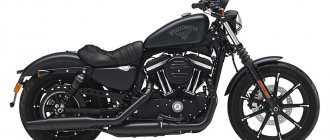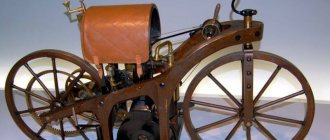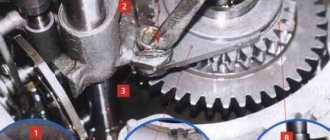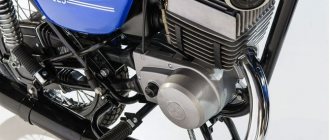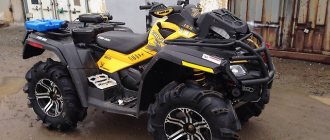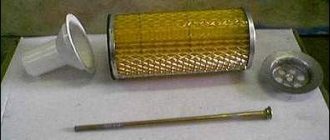Abordage_1
To appreciate the drive of biker life, look at the sophisticated motorcycles from all sides, and also plunge into the exciting life of the two-wheeled fraternity, you don’t need to go to the cinema. Having acquired 3D glasses, you can watch the film on Youtube.com (this video hosting, by the way, has begun to support the 3D format).
A short version of the experimental film about the best domestic custom bikes is below.
You won’t surprise Russia with homemade motorcycles and tuning. How do customizers differ from homemade ones, which are a dime a dozen in any garage cooperative? Having attended the premiere of a film about the modification of bikes, the website “Behind the Wheel.RF” officially declares: there are differences.
A custom motorcycle is a bike created according to a unique design, existing in one copy, the parts for which are made to order in workshops. This is not a pleasure for beginners or garage workers, however, unlike a vehicle assembled from scrap materials and somehow fitted parts, it is distinguished by the fact that custom is an art. Art that should not only be rolled out for the amusement of passers-by once a year, but should rush towards the wind, turn around, stop, and be easily controlled. In a word, to be a full-fledged driving machine that emphasizes the individuality of its owner.
These are the requirements that show participants around the world face. By the way, Moscow customizer Alexander Fetisov (Wick) is among the top ten best craftsmen in the world; in 2011, he took 8th place at the World Customization Championship.
The film includes stories of the TOP 5 most beautiful domestic bikes. In anticipation of the full version of the film, we present to you all five beauties, as well as their owners and the history of the creation of each iron horse.
MY MOTORCYCLE
Some may have a different question: is there any difference at all?! Some people generally confuse one with the other. Yes, you can even say that they are to some extent interconnected: choppers are also a kind of customization. But whatever one may say, chopper is one thing, custom is another, there are and will always be differences. And so let’s dwell on this topic in more detail!…
But first, a few words and terms: everyone is already accustomed to the fact that the lion’s share of technical terms is borrowed from English and German, and it would seem that it is quite enough to explain: “Chop”, “Chopper” - translated from English means: “truncated”, “cropped”, “Custom” is translated as “custom-made”, “made in an individual style”. This is, as it were, from a theoretical point of view!
Let's take a look at practice: “Customizing” is the process of creating a personalized vehicle, in particular a motorcycle, entirely with your own hands and according to your own design.
No one will probably say who was the first official customizer - that “nice guy” who was the first to modify his motorcycle based not on practical, but on aesthetic reasons, but many thanks to him. In which country this happened is also a moot point, because the technical level in Europe, Russia and the USA at the beginning of the 20th century was approximately the same. Therefore, we will only focus on the American direction of development of this type of “motor art” - there is no other way to call it! Early motorcycle customization began and developed in America at the same time as automobile hot rodding (see footnote below) at the turn of the 1930s. The craftsmen of that time did not attach much importance to the strict distinction: a car or a motorcycle, and therefore often engaged in the construction of both. Many of the terms used by customizers today come from hot rodding.
The name of various custom styles comes from their external features (silhouette, height, shape, presence or absence of a body kit), as well as from the purpose of the motorcycle (dragsters, board trackers, choppers). But this is a completely separate chapter in the history of each bike and we will not consider them for now.
The modern concept of “Customizing” has grown from handicraft robots to a scale that covers not only the construction and sale of an exclusive motorcycle, but also the cooperation of workshops for the production of exclusive parts, and the organization of international championship exhibitions on custom building, coverage of trends in the development of custom styles in a network of specialized magazines . Through numerous TV channels and glossy publications, the fashion for custom bikes has spread throughout the world.
Having something completely exclusive, new, mega-cool in your garage, no matter whether you drive or not, has simply become some kind of epidemic. Unique and luxurious bikes are now on par with cars. People really like the idea of owning something exclusive, and in order to ensure stable sales, large motorcycle manufacturers produce so-called “Kit Kits”, which allow almost anyone, by unscrewing a couple of nuts, to change the appearance of their motorcycle and feel like a great customizer .
Golden Chopper at the Seattle International Motorcycle Show
A selection of tuning spare parts is presented in special catalogues, hence the offensive term that characterizes an “Exclusive” motorcycle assembled from. The most popular term “Stock” is a motorcycle (or its part) with a factory configuration. There is a network of small-scale parts all over the world, but call it "stock" and you'll get a few extra holes punched in you! (with a glance) This is not a “stock”, this is an “aftermarket”!
Yes, it’s cool, it’s easy if you have a couple thousand extra bucks or our various tugriks (depending on where someone lives). BUT......the very idea of creating something of your own, with your own hands, from rusty scrap metal and other junk, or from a fresh “donor” – THIS IS JUST A HIGH. (and of course you can save a lot of money)))))) You will be satisfied, proud and confident in your iron horse! And customizing your motorcycle is not just about adding a couple of glove compartments and a high handlebar, but by completely redrawing the original version and creating your own vision of an ideal, harmonious motorcycle! And it doesn’t matter of fundamental importance whether you are building a chopper or a streetfighter, what matters is whether you put your “soul” into it, or whether you want to “fuck” money. 9 Mercantile creatures)))))) It was in America that the creation of custom motorcycles, in particular, a motorcycle in the “chopper” style, was put on a commercial basis and widely advertised. As always, commercialism won! They haven’t seen with what triumph he attaches a couple of trinkets to his “piece of hardware” and is madly happy about it, considering his moto to be a superbike. That's where the fun is in the world of motorcycles. Sorry I got distracted!
Thanks to the confluence of interests of craftsmen, filmmakers, businessmen and romantics, customization became popular in the States in a matter of years. The abundance of supply and demand allowed the Yankees to dictate fashion for quite a long time, until the beginning of this century, until their foreign colleagues strengthened their positions by regularly appearing at international championships. Then a new wave of interest in Old Skool arrived, in which most European and Japanese motorcycle creators worked and are working to this day, and the American ones have already forgotten. So don’t be surprised by the “unexpected” appearance of Dutch, French, Japanese customizers - we just learned about them late.
“Chop”, also known as “chopper” (if anyone still associates a helicopter with this word, fly for a beer for the more advanced!) is the name of the style that characterizes the product resulting from a once serial motorcycle after a radical intervention in its geometry frame and body kit shape.
As a result, the driver's seating position, height, base, length and width of the motorcycle, the ratio of the width of the front and rear wheels change, and the passenger saddle often disappears without a trace. Moreover, if the parts are simply cut off and thrown away forever, this is more likely a sign of building a “bobber,” but if the tanks, fenders, frames are cut somewhere and then added or overcooked, it will be a “chopper.” Almost all home-made workers are of the opinion that the number of exclusive (author’s) parts on a “chopper” should be maximum, and their combination should be harmonious. Although some, especially young, self-made artists believe that in this style everything that was possible has already been said, and they often sin with eclecticism - that is, mixing styles, which in itself is similar to balancing on a thin wire over a puddle of mud: the correctly chosen proportion - the birth of a new style, a step to the right or a step to the left is complete bad taste.
More experienced craftsmen, while remaining within the framework of the style, are able to diversify it through finely crafted details, elaborate finishing, drawing - all those pleasant little things that, although not striking at first glance, later make you admire the motorcycle for an hour. Chopper style, in in particular, what we mean by the word “Chopper” - a large and low, gutturally growling motorcycle, shining with varnish and chrome, with a wide, long front fork, a teardrop tank, a wide rear roller and, of course, a tall curved steering wheel - this style was not born “suddenly”, but predictably and consistently flowed from the ancestor of all the various and crazy things PROTEST. In the 20s of the twentieth century, motorcycle manufacturers were like workers at a demonstration. Even the largest (by the standards of that time) factories had problems with sales, and in order to push the buyer in the right direction, something more than a beautiful slogan was required. The only opportunity to demonstrate their technical achievements was the participation of motorcycles in sports racing. The requirements for their participants and the rules of the races depended on the organizers and often varied greatly, until, in the late 20s, the American Motorcycle Association (AMA) came onto the scene, which established strict requirements for the qualifications of riders and new competition rules.
Once you took part in an unsanctioned AMA race, you were deprived of the right to participate in competitions held under its auspices. Actually, this is where the term “Outlaw Bikers” was born at that time - bikers “Outside the Law,” that is, those who do not recognize the guidelines of the AMA. Ordinary motorcyclists were thrown “to the sidelines” of big sport, but they were not going to accept this... Single motorcyclists were not able to use the methods of boosting engines used by factory teams, and instead of increasing engine power, they simply reduced the load on it, reducing weight apparatus.
Ruthlessly subjecting their motorcycles to “trimming”, they removed the “extra” iron - they cut off the wings, changed the geometry of the frame to suit their dimensions, changed the landing, bent the handlebars, in a word, they gave their devices the most “sporty” look - they built the first “bobbers”. Signs of the “bobber” style are: a low steering wheel, a small angle of the steering column, front and rear wheels of the same size. They say that this style was initially called “Cut downs,” and originated in sunny California, on Long Beach... Later, in the 30s, such motorcycles began to be called “Bobbers.”
The Second World War put an end to this simple joy... Thousands of young people were drafted to the front. They set off young and full of strength to fulfill their duty to their homeland and, as usual, to earn some money, but having encountered the pain and death of their comrades instead of a heroic adventure, they only sought to return home as quickly as possible. At home, another disappointment awaited them: a satisfied, “victorious” America had already built a new order in which they had no place. An ideal consumer society, values imposed by advertising - what did they mean to thousands of rejected people who, until recently, were forced to kill so that they wouldn’t kill you?! What to do? - the motorcycle became a symbol of Freedom for them... Veterans and restless youth on trophy and refurbished old motorcycles rode along the highways at night, growling in direct currents, huddled in flocks, organized races for bets - society rejected them, and they, in turn, despised society... In the end In the 1940s, interest in motorcycle racing increased again. Crowds of motorcyclists gathered in the town of Hollister (California) for the next race held under the auspices of the AMA. This time there was a brawl, which marked the beginning of a big scandal. Numerous media outlets picked up the accusations against independent motorcyclists, and since then, bikers have been widely considered anti-social elements.
In 1954, the oft-mentioned film The Savage, starring Marlon Brando, was released. The hero of the film, like most of his teammates, drove a relatively fresh 650 cc Triumph Thunderbird, launched into production in 1949. By the way, the “colors” worn by the club in the film (a skull with crossed pistons on connecting rods) are a copy of the stripes of one of the oldest American clubs, the Outlaws.
This film was one of the first attempts to show that “Bikers are different...” and that “They are not all as bad as we think of them,” as well as a good illustration of the American motorcycle park of that period. In addition to their native Indianas and Harleys, American motorcyclists could ride BSAs, Triumphs, Nortons, and Vincents. And later - on Kawasaki, Honda, and other Japanese motorcycle brands. Bought, stolen, captured, assembled from spare parts in landfills, steel horses carried their owners to victory above the magic numbers of 100 miles per hour.
Since the “bobbers” were more of a racing tool than a simple means of transportation, the “fight against excess weight” also affected such a thing as a starter - many motorcycles were started “from a pusher”, and to make life easier for assistants pushing the future “champion” at the start , the rear wing mount became more and more massive. Much later, at the end of the 50s, this element migrated to “choppers”, having undergone various changes, it finally became just a long back, practically bearing no functional load, at the same time changing its name from the respectful one - “push-bar” ” to ironic - “sissy-bar”. At the same time, the “chopper” style finally stood out from the “bobber” environment and began to be characterized by a long front fork and a tall handlebar, called the “eyphanger”.
The most famous masters of that time who built choppers were: Ed Roth, Vaughn Dutch, Gary Littlejohn, C.B. Clauson, Ron Pough, Bill Carter. The image of “bad guys” attracted the attention of filmmakers, writers, and artists; with their help, the hobby for choppers was popularized and developed into a powerful industry, producing, in addition to motorcycles, tuning parts, clothing, and accessories. Exhibitions of customized motorcycles and cars were held together for the first time. By the way, it was with exhibition photographs that the widespread lengthening of the front forks began: working at custom exhibitions, photographers discovered that the motorcycle taken “from the knee” looked more dynamic, but in the cramped conditions of the exhibition they had to resort to shooting with a wide-angle lens, and when printing the photo the front fork looked very long.
Naturally, readers of custom magazines perceived this as a new trend, and began to make forks one longer than the other; “show” customizers were followed by ordinary bikers who made motorcycles for riding, and not for show... Growing forks became not only impractical, but also dangerous : most often the stays of telescopic forks were lengthened through spacers, and when changing the angle of the steering column, they did not think about strengthening the welding points with “kerchiefs” - at high speeds and large potholes, the flimsy structure fell apart and sent the driver to another world. Plus, some fans of minimalism refused to use front brakes! (like “Captain America” in “Easy Rider”) True, this style direction did not catch on (perhaps it simply died out, because for a 200-kilogram motorcycle one rear brake was certainly not enough). In the second half of the 60s, the hysteria began to subside: the geometry of the frame changed for the sake of handling, the number of workshops growing, offering kits for boosting engines, exclusive body kit parts, painting, airbrushing (the so popular “flame”, “scallop”, and “pinstriping”) "). In 1965, Ed Roth published the first chopper magazine, and several more publications soon appeared. "V-Twin", "SuperCycle", and others. "Easyriders", for example, remains one of the most popular today. This is how protest, born on the sidelines of big sport, growing up in old workshops in the backyard, living in search of freedom and self-expression, has grown into a powerful subculture on a global scale. Now “Chopper” is something more than just a motorcycle made in this style.
By the way, many closely associate custom culture, and especially the “Chopper” style, with the Harley Davidson motorcycle. This happened largely due to the exploitation by filmmakers of the image of the “cool Biker” - the 60s, becoming the heyday of custom culture, were also the era of rock and roll, and LSD, the hippie movement - all this promoted the destruction of old values, putting personal spiritual freedom of a person. The motorcycle was the perfect embodiment of this idea! The famous American actor and producer Peter Fonda perfectly showed this same image in his film “Easy Rider” (1969). “You want freedom - take it, everything you need will fit on your motorcycle!” (and in the gas tank - see the film). Well, since Fonda is one of the most ardent fans of the Harley Davidson brand, it is natural that both “Choppers” in this film were built on the basis of this motorcycle.
The same Peter Fonda, having heard the statement that “America has given the world nothing but the dollar and the Harley!” – reacted sharply: “And that’s enough!” Subsequently, this motorcycle became the hero of all films with his participation. During the Great Depression (after the financial crisis of 1929), Indian remained almost the only motorcycle manufacturers in the country.
Moreover, “Harley” was in a much more advantageous position due to the fact that it had previously lured over to its side the former customers of the “Indian”, who were left with nothing while supplies of motorcycle equipment continued for the First World War. Further, the company's management relied on the production of motorcycles with a cubic capacity from 750 to 1200 cm/cc, having received an order that helped it “stay afloat” until the mid-50s, when the “Indian” and “Vincent” “left the stage” » – production of motorcycles for the police. In the 50-60s, only Harley produced large V-twins. And finally, in 1970, William Davidson (the grandson of one of the founders) convinced the company’s management to use fashion trends in chopper building in the appearance of the motorcycles produced. “Why not immediately give people what they want?!” he suggested, becoming the chief designer.
In 1971, the “Super Glide” model debuted, featuring a massive rear and openwork front, a step saddle, a high handlebar, 1208 cubes and 65 hp. The features of the new style were finally consolidated in the “Low Rider” model in 1977, and now manufacturers proudly add the word “Custom” to the name. The government again came to the company's aid in 1983, when the Reagan administration imposed an increase in import duties on motorcycles with a displacement of more than 700cc for a period of 5 years, and also gave an order for the production of weapons. Harley managed to “swim” for the second time by improving the quality of its products. American engineers went to a “master class” with their Japanese colleagues, and after production innovations, sales increased several times. Taking into account all of the above, it is not difficult to admit: there was simply no one to become an “icon” of style except “Harley Davidson” in America, and later throughout the world, hence the myth that a real “Chopper” should only be with “ Harley's V-twin. But this is their opinion, which is not particularly listened to now. (This is my opinion) Whoever wants does it from any material they like.
I have nothing against Harleys, but they still lost a little fans. Although they still remain a “style icon”
In conclusion, we can say that in the robots of customizers one can guess both a mixing of styles and a transition to something newer and more modern - that’s why it is “Customizing”, and “Choppers” will never lose their former glory and will not mix with other styles! ………..
Hot-rodding - Building a representative of the “Machine is a Beast!” class from a production car, including strong external modification and engine boost.
chimera
"Chimera".
Host: Alexey Sheverev. Workshop: “T&V Custom”, creators: Alexander “Torych” and Violetta. Awards: 3rd place at the Moscow Custom & Tuning Show 2011. History: as Alexey Sheverev states, there is no motorcycle like the Chimera in Russia. This motorcycle is a representative of “full-custom” - the most advanced trend in customization. "Chimera". Host: Alexey Sheverev. Workshop: “T&V Custom”, creators: Alexander “Torych” and Violetta. Awards: 3rd place at the Moscow Custom & Tuning Show 2011. History: as Alexey Sheverev states, there is no motorcycle like the Chimera in Russia. This motorcycle is a representative of “full-custom” - the most advanced trend in customization.
Is a custom motorcycle safe?
People who take the issue of safety very seriously often ask the question of how safe a motorcycle they assembled themselves is. There is nothing wrong with this, because motorcycles not assembled at the factory can indeed differ from factory motorcycles. If, when creating a factory motorcycle, the manufacturer does everything according to technology and takes into account all the factors affecting the rigidity of the structure, then homemade motorcycles are made somewhat differently. On the one hand, this is true, but only if you are going to order the assembly of a motorcycle in some Uncle Vasya’s garage.
Real custom motorcycles are produced in appropriate workshops that approach their work with the utmost responsibility. The most famous workshops that deal with work of this complexity are Orange County Choppers or West Coast Choppers. These guys really know a lot about two-wheeled vehicles, so they have never had a dissatisfied customer. Among the Russian workshops that do their job just as well are Fine Custom Mechanics, King Kong Custom, Motodepo CS and others. Today these are the most famous Russian workshops, which have managed to complete several successful projects.
If you have seriously decided to start developing a custom motorcycle, then you should contact one of these workshops. Only in this case can you be sure of the quality and reliability of the work performed. In addition, the guys offer their own warranty on the motorcycle they make, and in case of a breakdown you can return to them.
"Boarding".
"Boarding".
Host: Igor Yakimchuk. Workshop: “Workshop of Yuri Shifa.” Story. According to the owner, Igor Yakimchuk, the motorcycle embodied his two main passions: the pirate theme and bikes. "Boarding". Host: Igor Yakimchuk. Workshop: “Workshop of Yuri Shifa.” Story. According to the owner, Igor Yakimchuk, the motorcycle embodied his two main passions: the pirate theme and bikes.
mishka
"Bear".
Host: Andrey Kuznetsov. Workshop: Big Bear Shoppers. Story. The only custom included in our rating that was assembled in America, in the legendary Big Bear Сhoppers workshop. The bike was named “Mishka”, apparently in honor of his parents. "Bear". Host: Andrey Kuznetsov. Workshop: Big Bear Shoppers. Story. The only custom included in our rating that was assembled in America, in the legendary Big Bear Сhoppers workshop. The bike was named “Mishka”, apparently in honor of his parents.
Muha
"Fly".
Host: Nikolay Ignatiev, president of the Harley Davidson Russia club. Workshop: “Motto-. Host: Nikolay Ignatiev, president of the Harley Davidson Russia club. Workshop: "Motto-Center". Four of our five nominees (except for “Mishka”) were collected in domestic studios and Belarusian workshops. One cannot but rejoice that such an unusual movement has its own masters in Russia.
The Chimera motorcycle is a unique project for Russia. This is an example of a so-called full custom, where all the parts are made specifically for this motorcycle, including the frame, engine and transmission. The rest of the bikes are assembled on the basis of the Harley Davidson Custom motorcycle frame. As the owners of the motorcycles said, they are forced to take a factory frame by the requirements of Russian legislation, according to which a completely homemade motorcycle simply will not pass certification. Unique motorcycles built on the Harley-Davidson frame initially have the necessary documents allowing them to travel on public roads.
You can imagine that even with the availability of funds (the amount of which the guys discreetly kept silent about), the construction of a unique motorcycle, on average, takes two years. The plans of Andrey Kuznetsov (Mishka motorcycle) to build a second bike in eight months are laughed good-naturedly by his teammates.
What is a custom motorcycle
Have you ever thought about creating your own motorcycle based on another, or maybe just tuning and modifying an existing motorcycle model? If yes, then you are one of the people who prefer unique bikes instead of those that anyone can afford. A custom motorcycle is a bike that is made to order for one person. Simply put, such motorcycles are unique in their kind and have no analogues.
The very idea of custom motorcycles dates back to the 90s, when American bikers decided to create the first custom bike. At first these were minor modifications or reworkings of existing models, which were equipped with different wings or unusual wheels. Afterwards, a large number of craftsmen appeared, and today you can order a motorcycle from the workshop, which will be assembled completely from scratch, including the frame.
nick
What makes fans of custom bikes, forgetting about cozy sofas and large TVs, stay in workshops at night, building, honing, perfecting their bikes, when the vast majority of fans of a breeze just buy a production model?
Answering a question from journalists, a brutal man Alexey Sheverev (Chimera motorcycle), dressed in a leather jacket, with a glass of whiskey in his hand, suddenly changed his face and in epithets full of romance, said that “custom is something you need to grow into” .
A motorcycle is a part of its creator, every detail, every stroke is born from the depths of the soul. A motorcycle is a child. And if a stock bike gives birth to a spark in the soul, then a custom bike is a flame that flared up from a spark. Well, these are wonderful words, and even if not everyone shares and is inspired by the idea of custom motorcycles, at least customizers and their iron horses have now become closer and clearer to us.
Five of the coolest custom bikes from Russia
Sport-Evolution
This custom is not for mere mortals, as even the base model KTM 950 SE is not affordable for everyone. It was built in the Sport-Evolution garage by former racing driver and engineer Dietmar Franzen , who typically builds cafe racers, scramblers and bobbers with a special love for classic BMW engines. It even produces its own TÜV (Technischer Überwachungsverein) approved parts.
One day a client came to us and said: “I have this KTM somewhere at home, just make something out of it,” recalls Dietmar. -But creating a cafe racer from a 950 Super Enduro is too difficult. But giving up is not our style.
Custom KTM 950 Super Enduro
